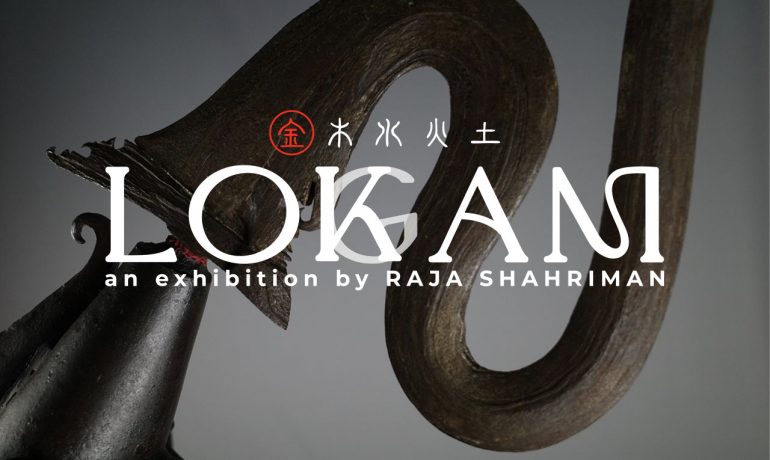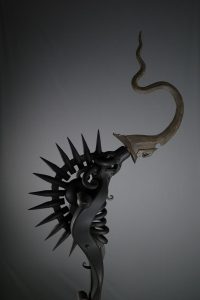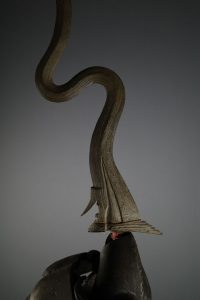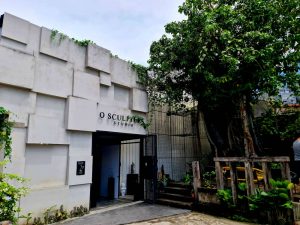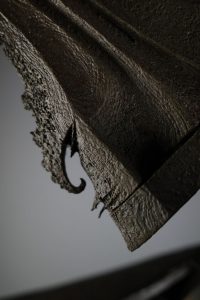“From a spiritual (Islam) aspect, the metal itself is about strength. It means that to be strong, we take a strong metal, develop and use it.” – Raja Shahriman.
By Eeyan Chuah
The word ‘Lok’ derives from ‘kelok’ which means twist or bend. It is a term used to state the bending and curving of a keris blade. ‘Gam’ on the other hand is how you pronounce the character ‘金’ in Cantonese, which means metal. Together they form the word Lokgam. Pronounce it as Logam and you get the word metal in Malay.
Lokgam is an exhibition presenting sculptures by veteran artist Raja Shahriman Raja Aziddin (b. 1967, Kuala Kangsar)—a Fine Art graduate (1986–1990) majoring in Sculpture from Universiti Teknologi Mara and specialising in producing works rooted in the identity of Malay culture. These sculptures are from his series of works aptly titled “Lok”.
Indeed, by applying the same ancient steel forging technique used by generations of Malay blacksmiths to create the symbolic keris, Raja Shahriman’s works are often emblematic of the Malay identity. In this series, each sculpture depicts a welded iron figurine of a human torso with a keris as the head.
Lok 7: Sengketa Alam (2019), Metal-forged & fabricated, 24 x 40 x 103cm. Image courtesy of Wei Ming
Raja Shahriman explains that the torso represents the physical form of the human body—the greatest form of creation by God; while the keris is created by men as a reminder of their creator—God. “I want to tell the story of the Malays through their culture,” he says. “The keris is symbolic of the Malay race and represents the dignity and identity of the Malays. It represents the philosophy of the Malays. When I place the keris on the head, it becomes the face to the body. It becomes the face of the Malay (culture), not in form but rather in philosophy.”
The keris in this series is forged with the distinct twists and curves of the ‘Lok’ design, hence the title of the series, but it deviates from the functional form of a blade to become a form of expression. The curvature of the keris has been exaggerated to convey the trials and tribulations in a person’s life. The curvier the bend of a blade, the heavier the burden and challenges a person will face during their lifetime, not unlike how the river bends by the erosion of flowing water.
Lok 6: Genta Setara (2018), Metal-forged & fabricated, 26 x 22 x 100cm. Image courtesy of Wei Ming.
“On the philosophical aspect,” Raja Shahriman continues, “I want to show that the body is the bearer of today’s challenges while the ‘Lok’ represents life’s journey. It tells the tale of a time when challenges are unpredictable as life grows increasingly uncertain in this era of development; when change and development have no focus or direction, and results in the erosion of moral values, civilisation, and humanity.”
A warrior or a person worthy of the keris would need the strength and flexibility required to wield a weapon of such burden. The kind of strength and dexterity every person needs in order to overcome the differing hardship in each of their lives.
The full series of Lok was first opened to the public at National Art Gallery of Malaysia in 2019 and now seventeen of the sculptures have made their way to Penang and are on display in O Sculpture Studio@Hin Bus Depot until the 4th of June 2023. Admission is free and all are welcomed to visit.
Image courtesy of Low Chee Peng
O Sculpture Studio is run by local artist Low Chee Peng who is a sculptor himself. Low has known Raja Shahriman for about twenty years, both being veterans in the field, and has always been an admirer of his works.
“Not many people have the patience and endurance to take up a craft as old and challenging as forging steel anymore,” Low comments when asked to give his take on Raja Shahriman’s works, “and to do it in a way that manages to create artworks so elegant from hard materials such as scrap steel. To me, his creations are always filled with such grace and strength, a balance that is really hard to achieve.”
Lokgam is the first of five in a larger series of exhibitions throughout the year curated by O Sculpture. The sequence of exhibitions is curated based on the theory of five elements with Lokgam being a wordplay on Logam, the first of the five elements.
“I wanted to create a series of sculptural exhibitions based on the different elements to showcase how broad the range of sculptures can be. Sculpture as an art form can encompass many materials, it can come in many shapes and textures,” Low explains. “For example, after metal comes wood, a material though being hard, is considerably warmer and softer than metal. Then, we have water, and then comes fire, and lastly earth. What would those look like in sculptural form?” he muses.
Coincidentally, there are also elements of earth, fire, water, wood and, of course, metal in the making of a keris. “The shine in the metal depends on the metal content and mixture.
Details of pamur on the keris. Image courtesy of Wei Ming.
For example, if the mixture contains chromium, it becomes shiny. If there is nickel, it will have the characteristic white streaks and spots in the design,” Raja Shahriman explains in an interview with the curator of Lok, Faizal Sidik. “In the Malay world, we not only understand metal mixing, but we go deeper into the details of the metal design. Each metal design on the keris is known as the ‘pamur’. Pamur not only brings luck, it is also a symbol of status and attire or fashion. The keris in the Lok series were made using carbon and mild steel. If you look closer, you will see that the pamur it produces looks like veins in the metal.”
When asked what he hopes the audience will take away from the exhibition, Raja Shahriman expresses that he hopes his works would inspire more artists to learn about sculpting—a medium he finds lacking in our local art scene, and to explore out of the box and experiment with different sculptural forms. He also wishes this exhibition to be a catalyst to spark interest in our many dying traditional arts and skills among the younger generation of artists.
Eeyan Chuah is a writer based in Penang.

